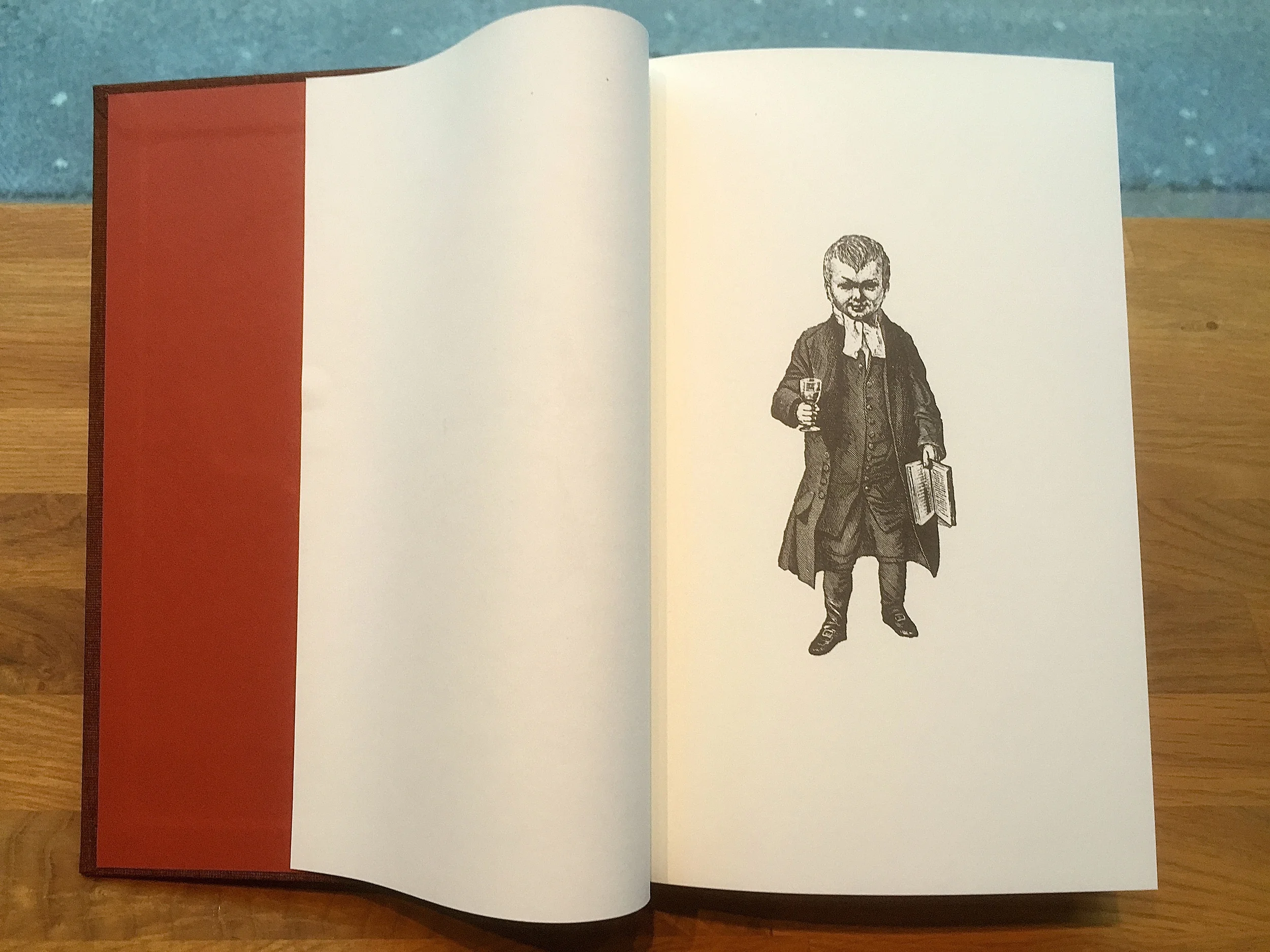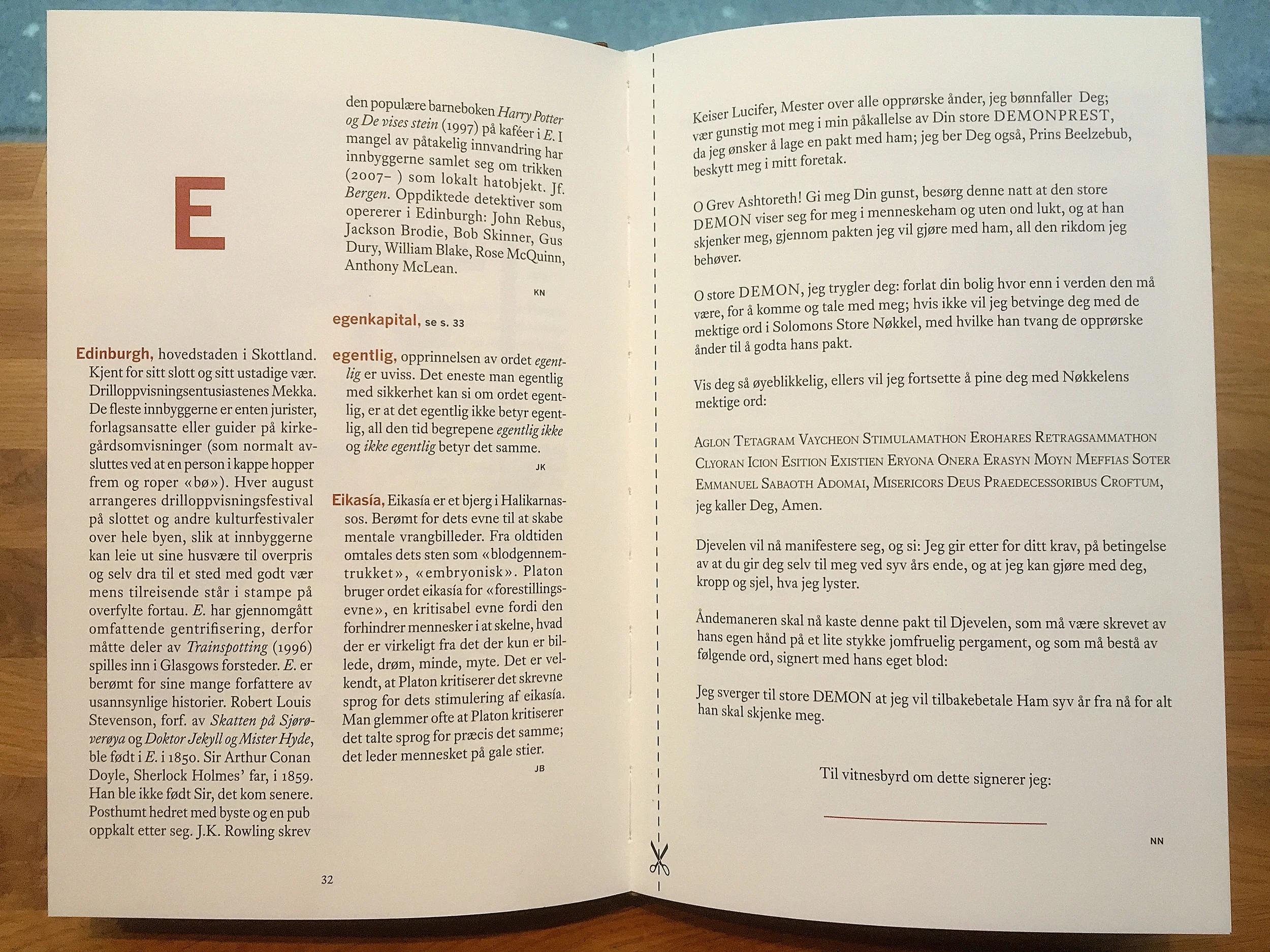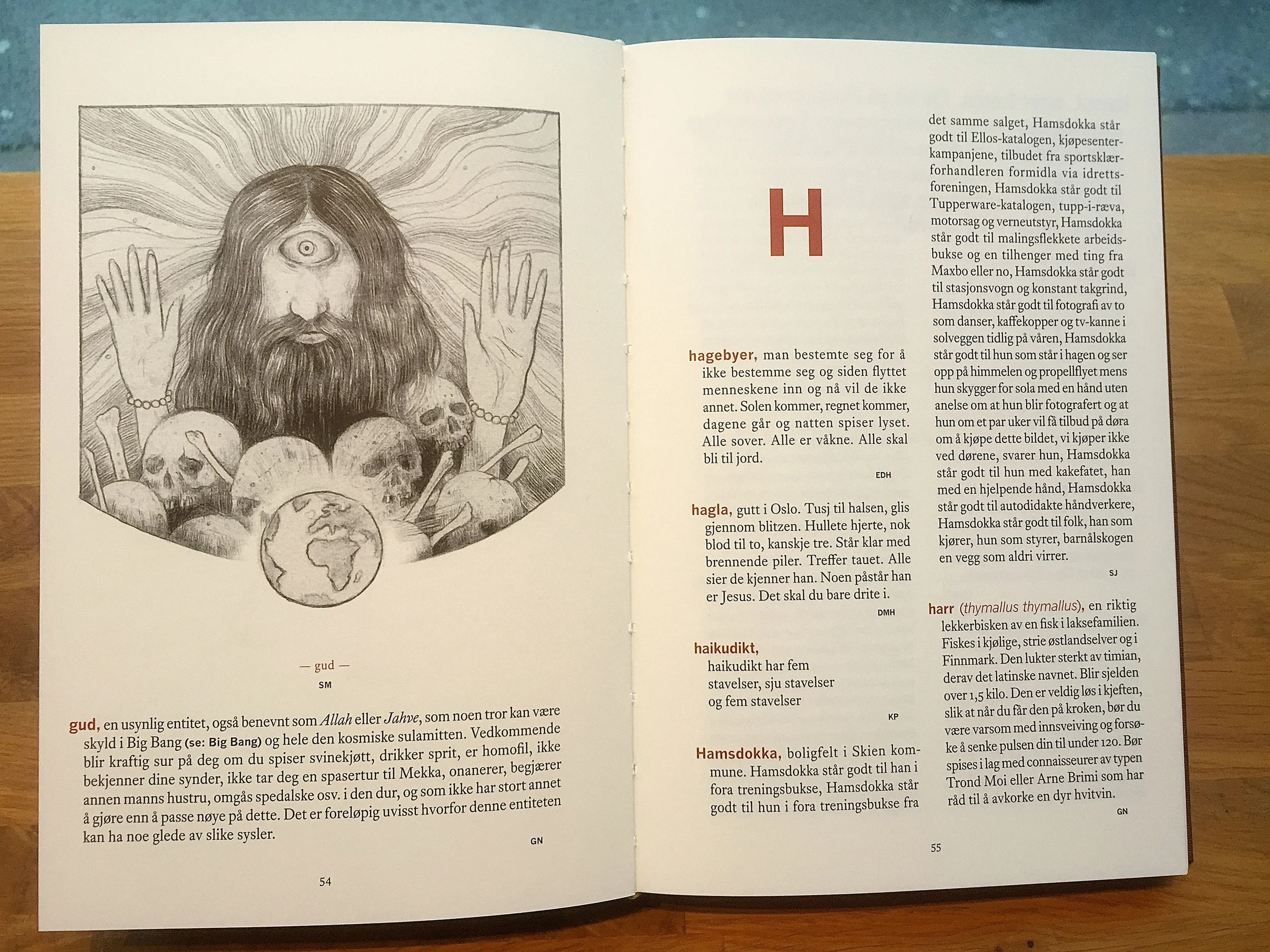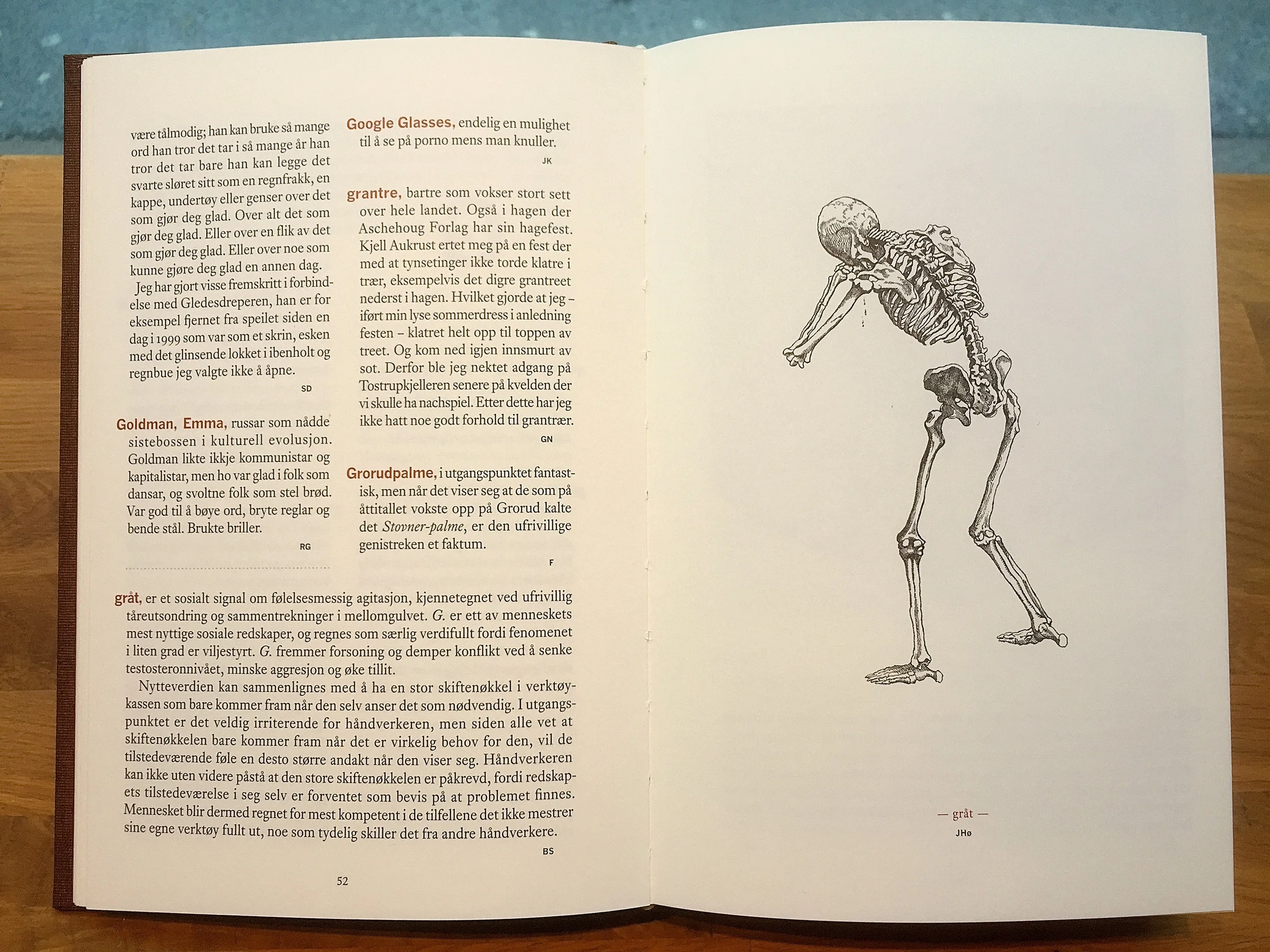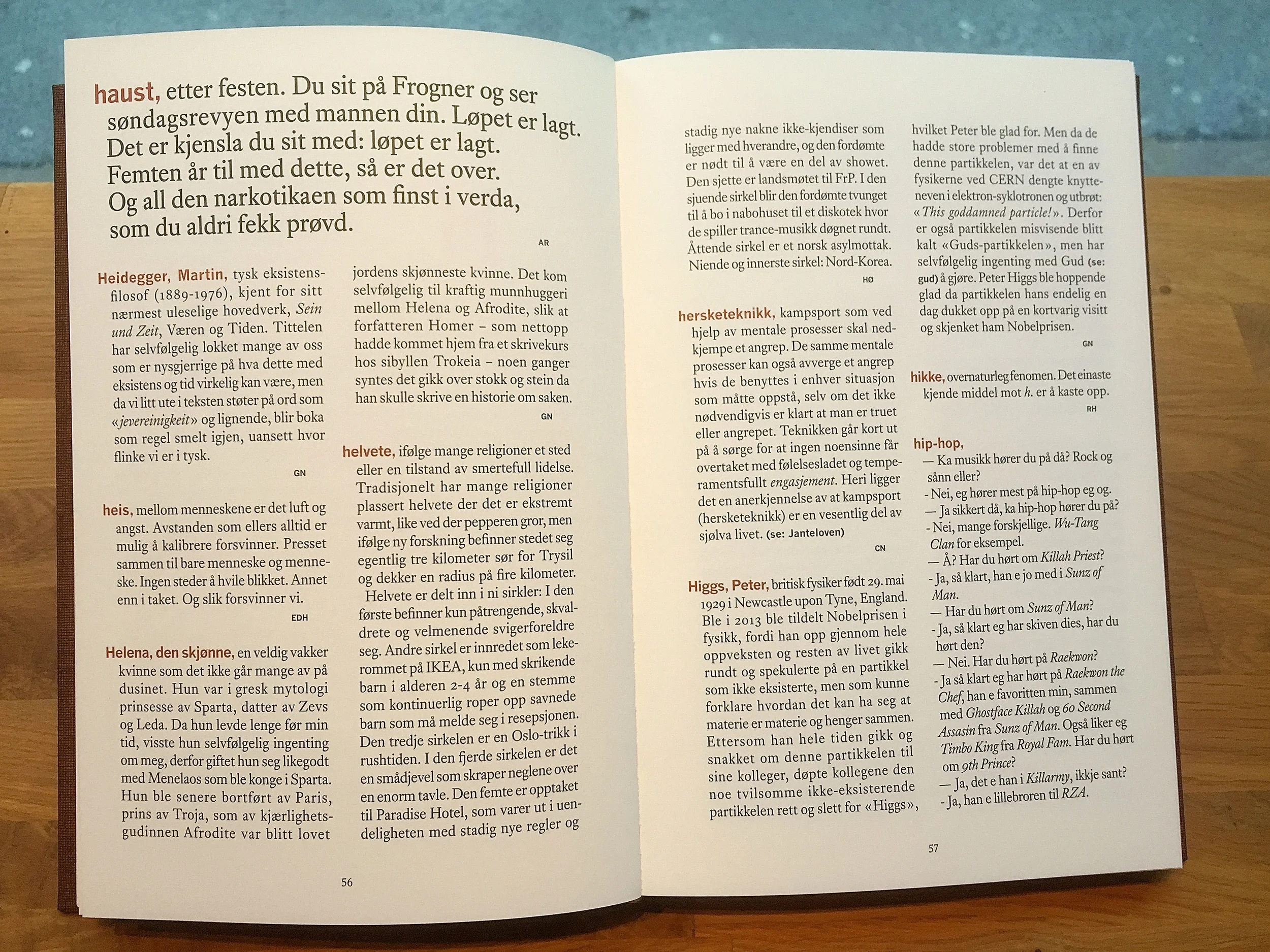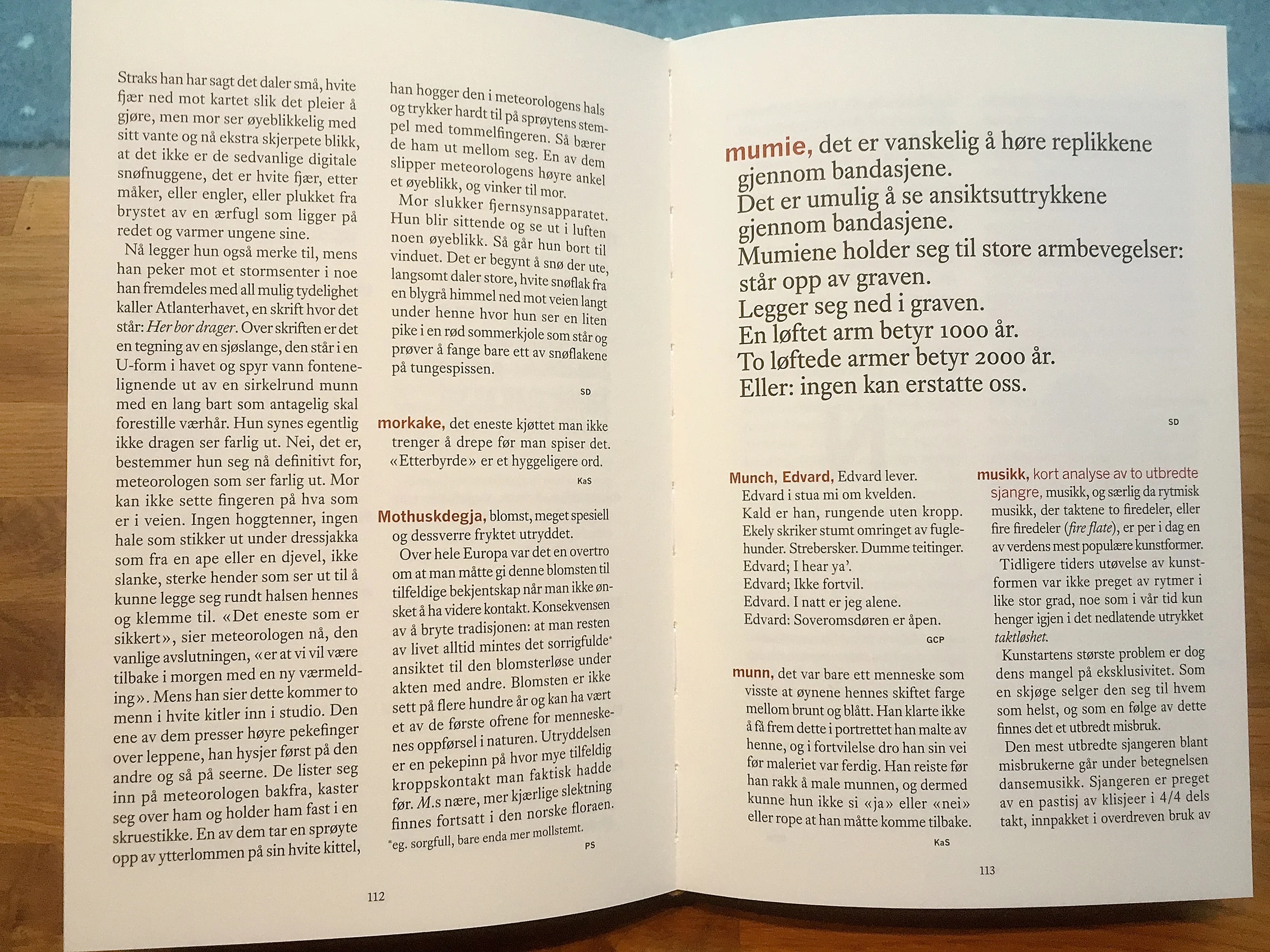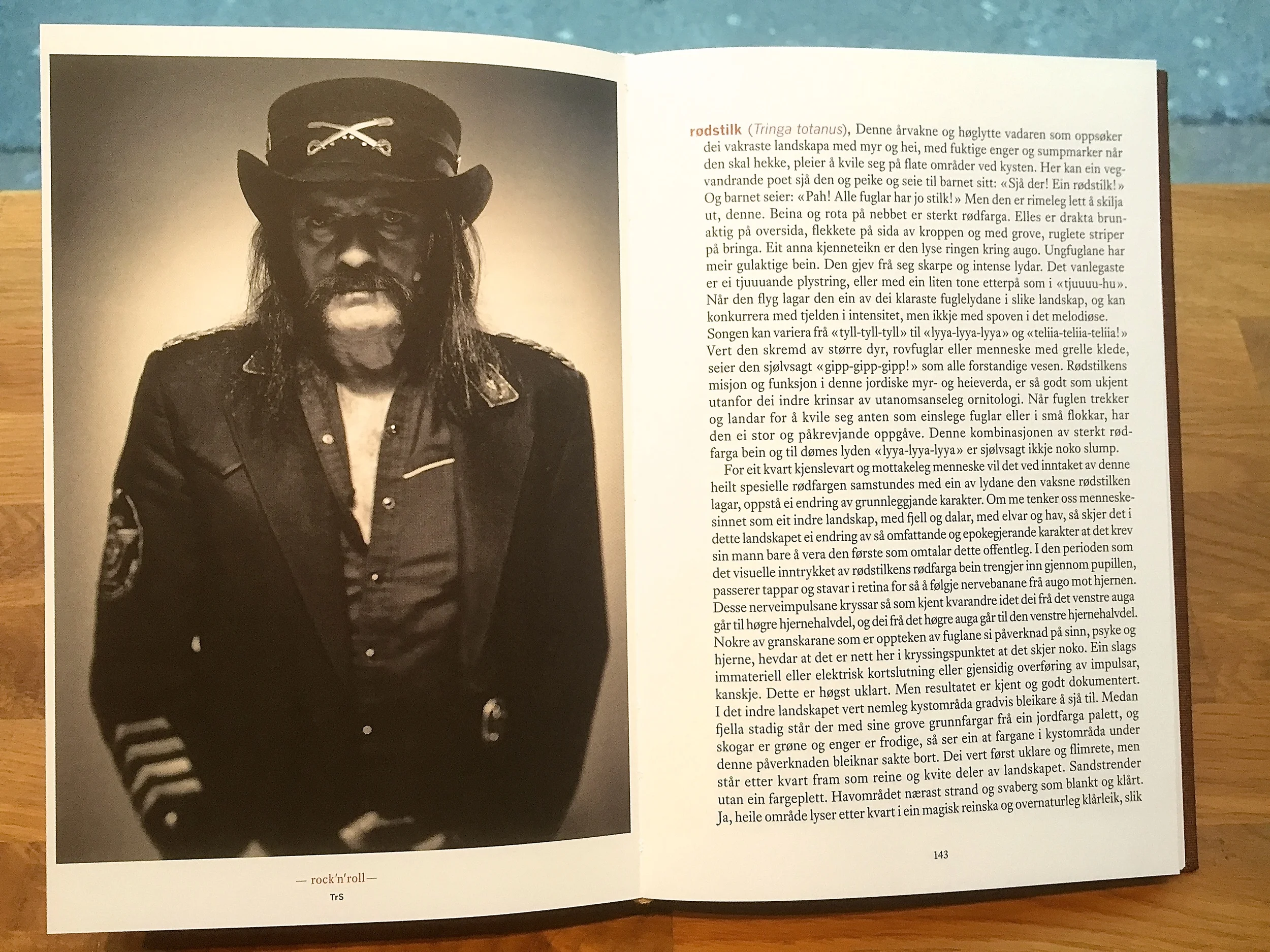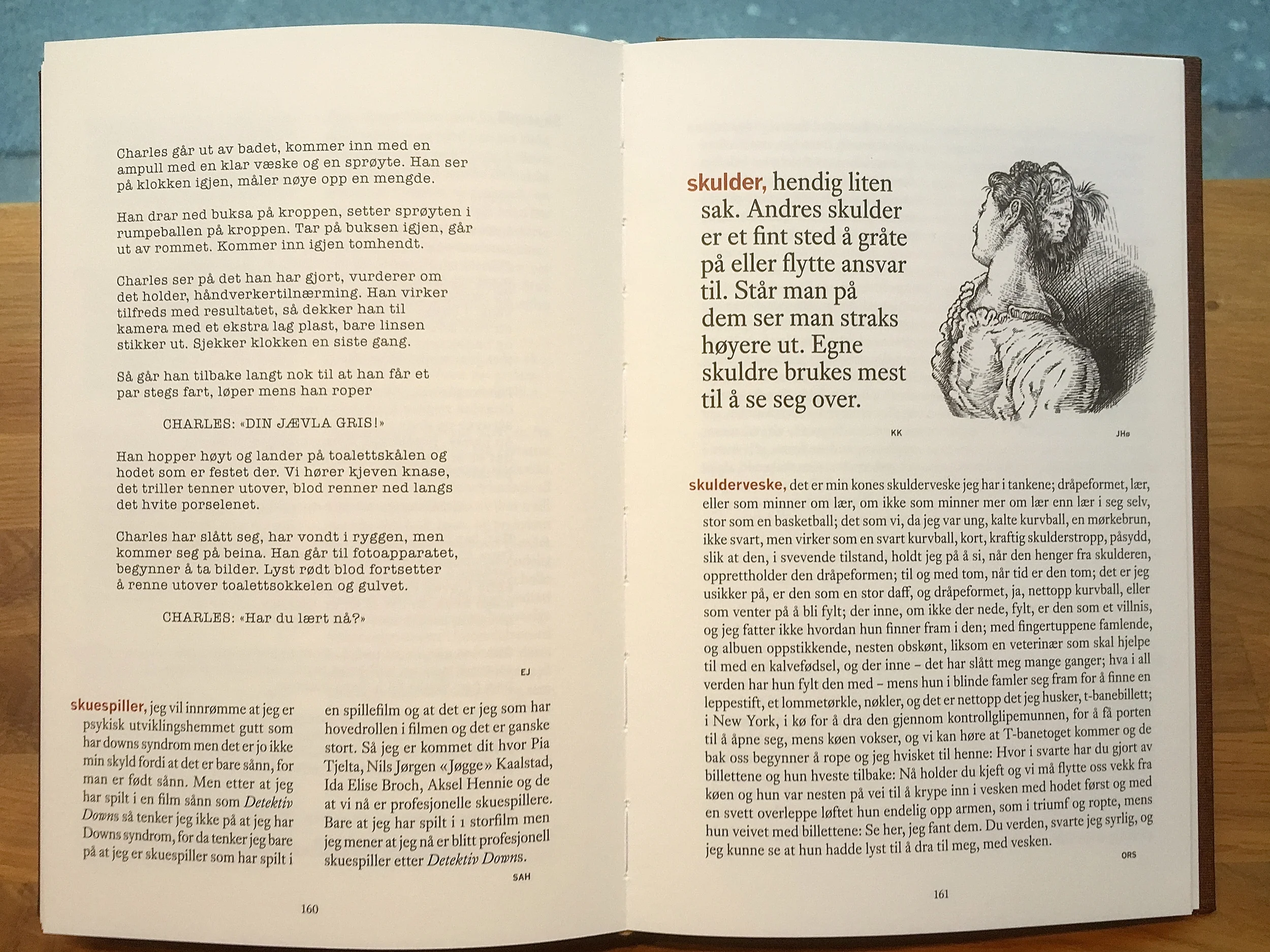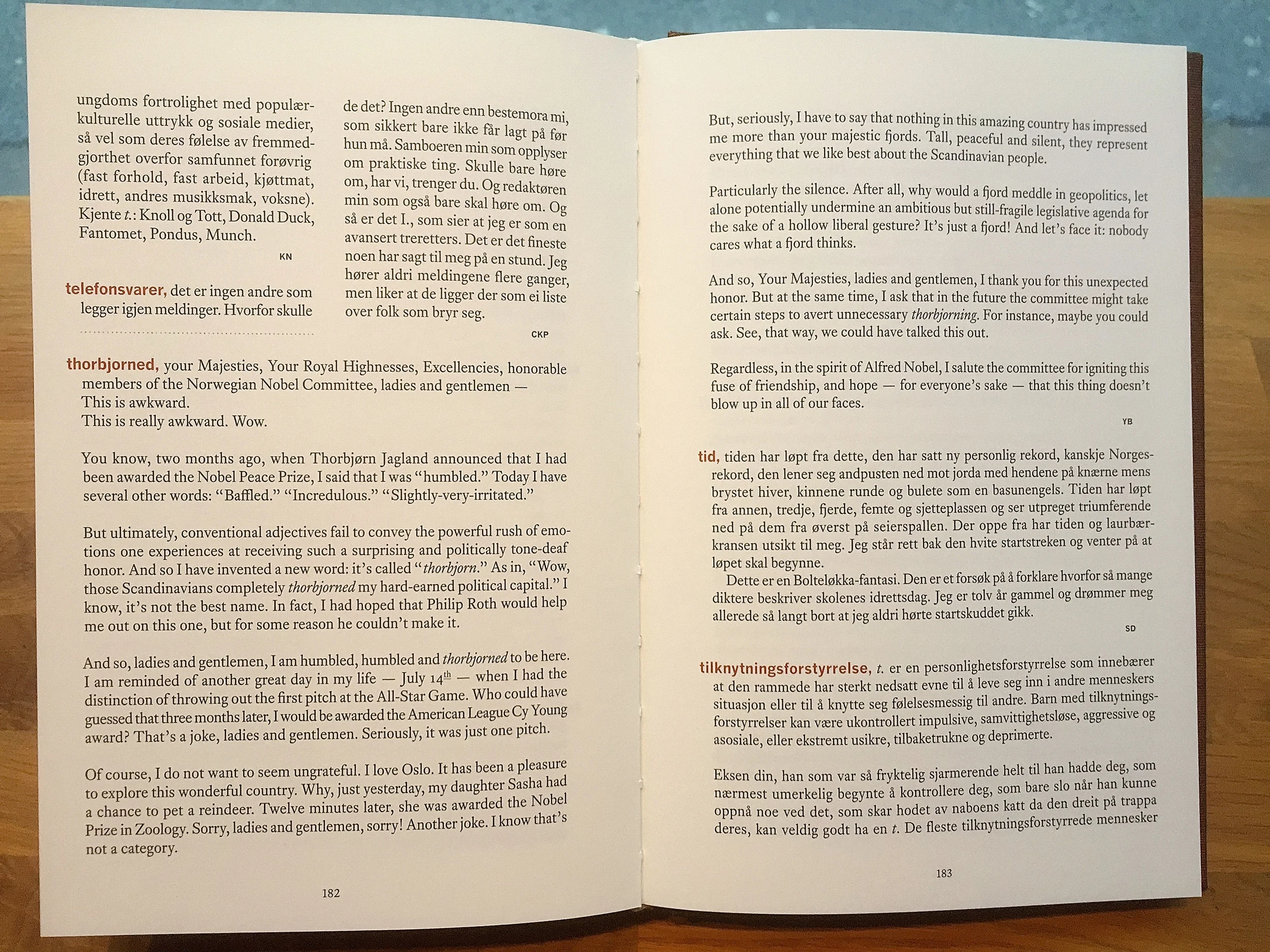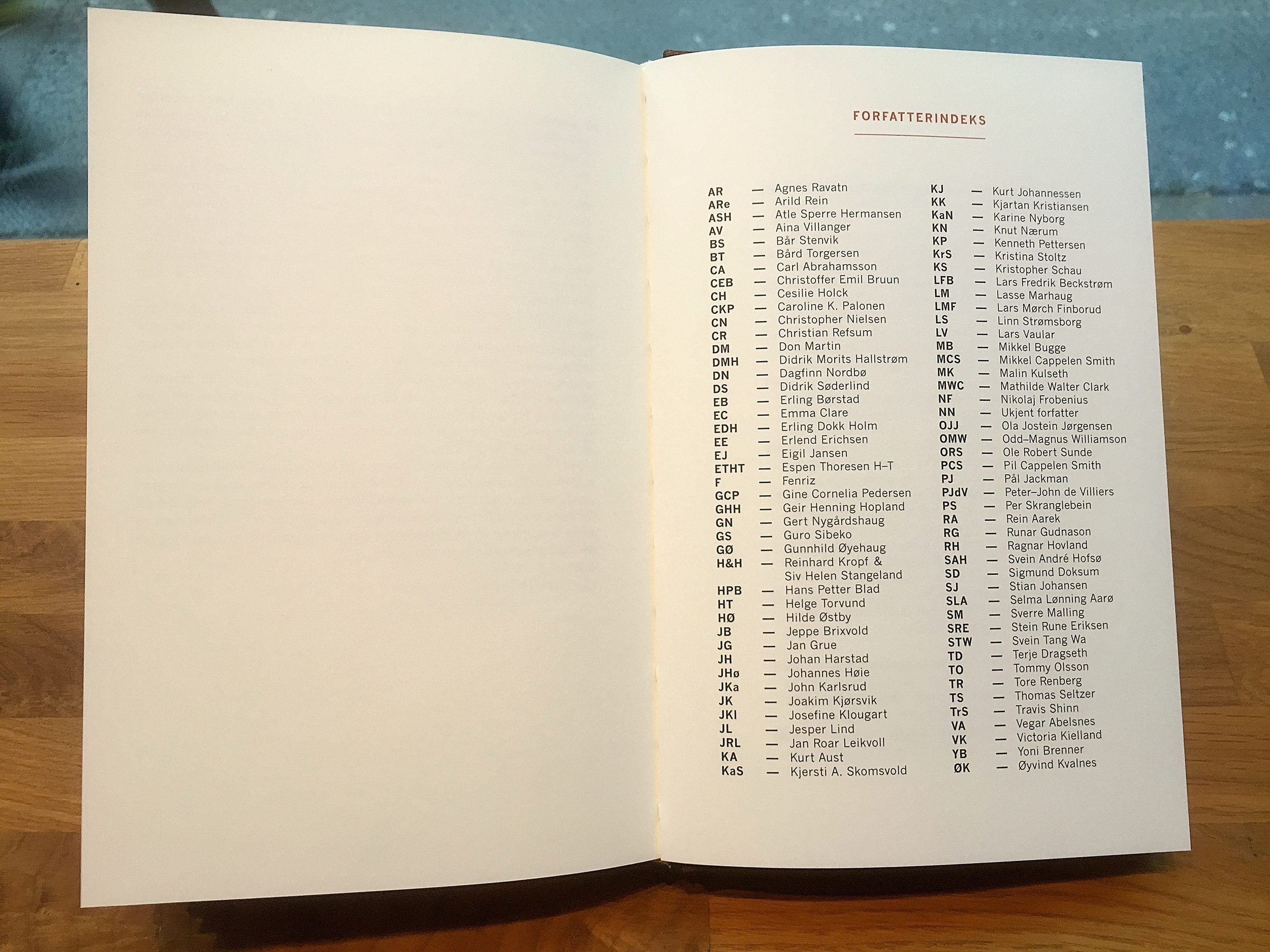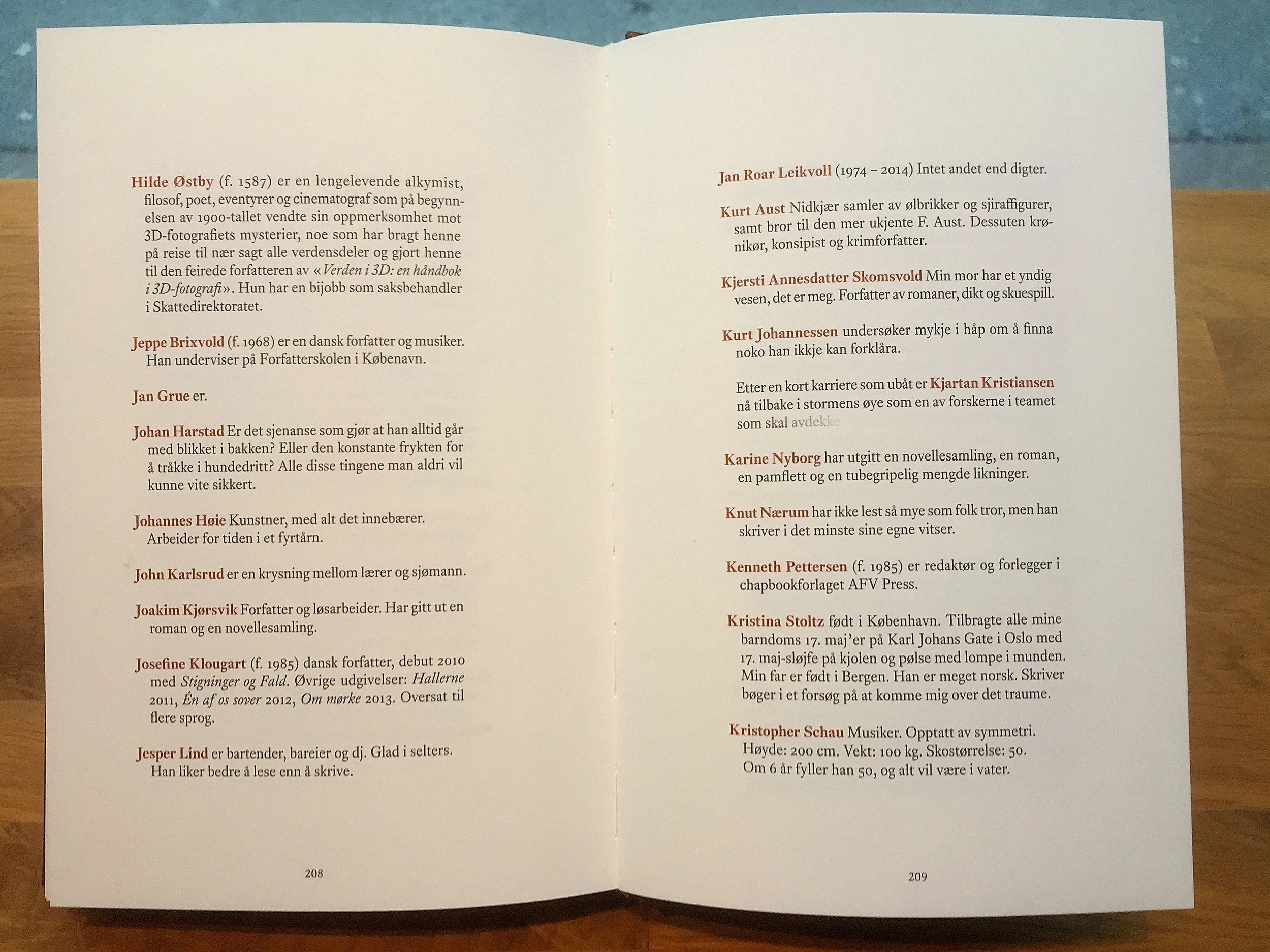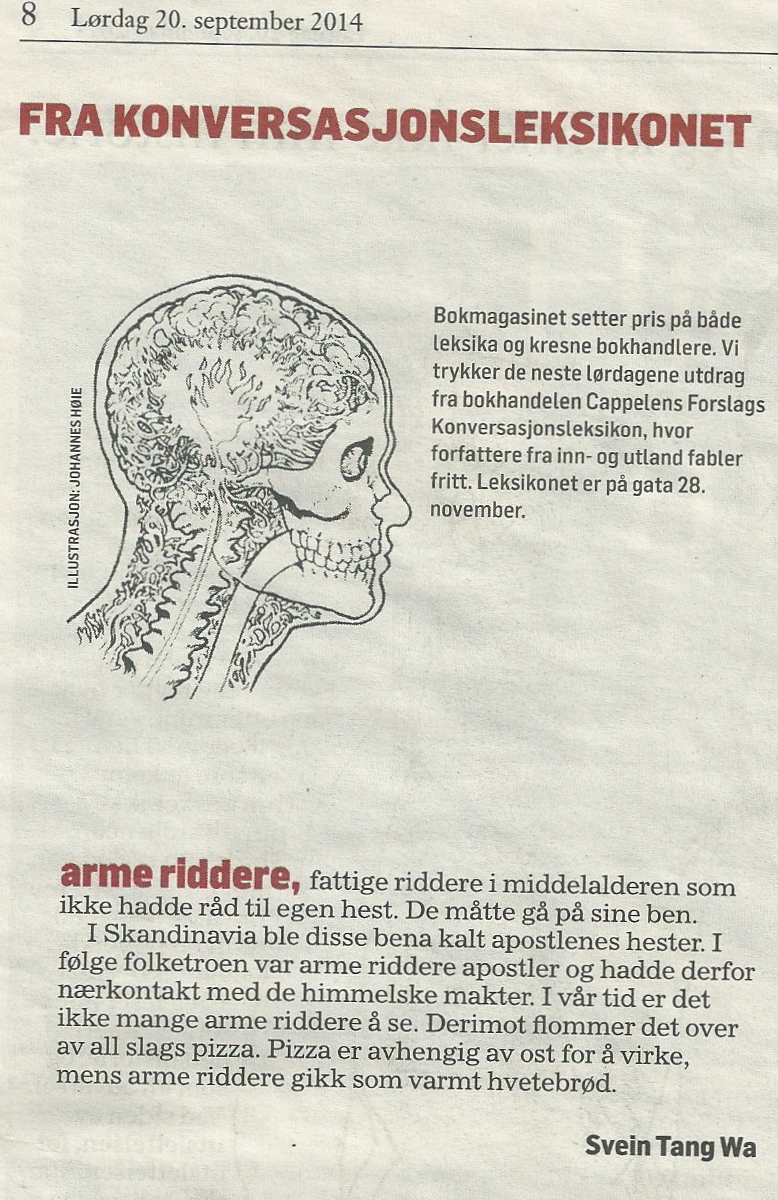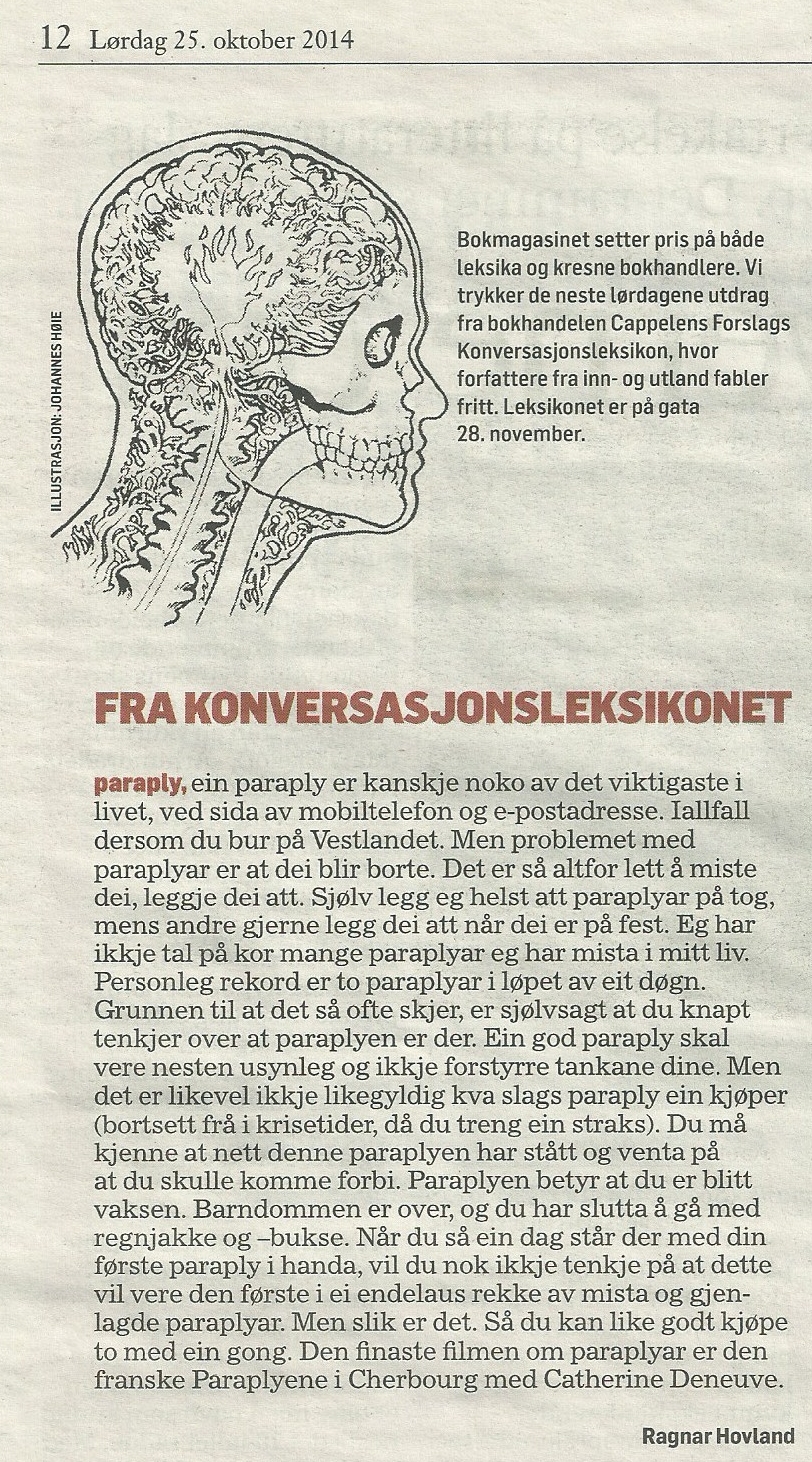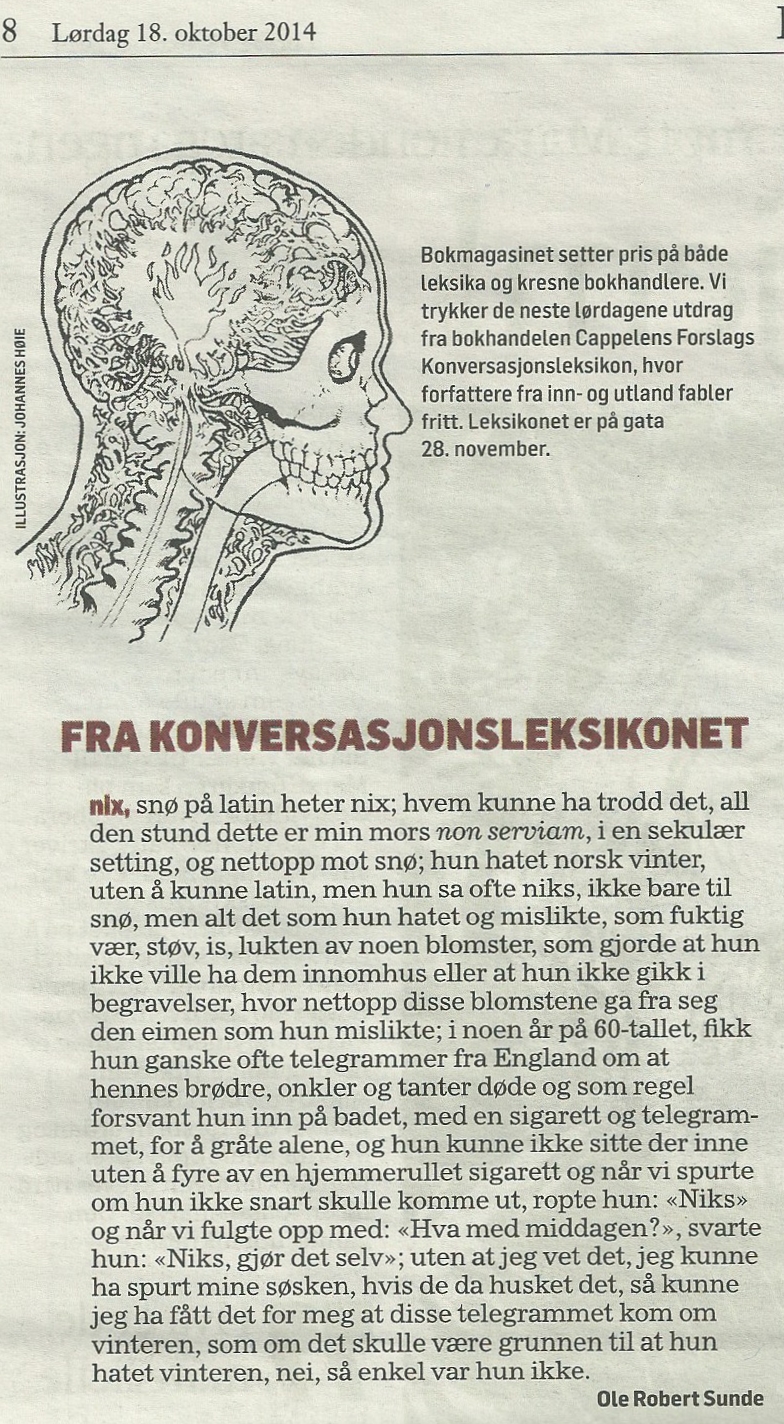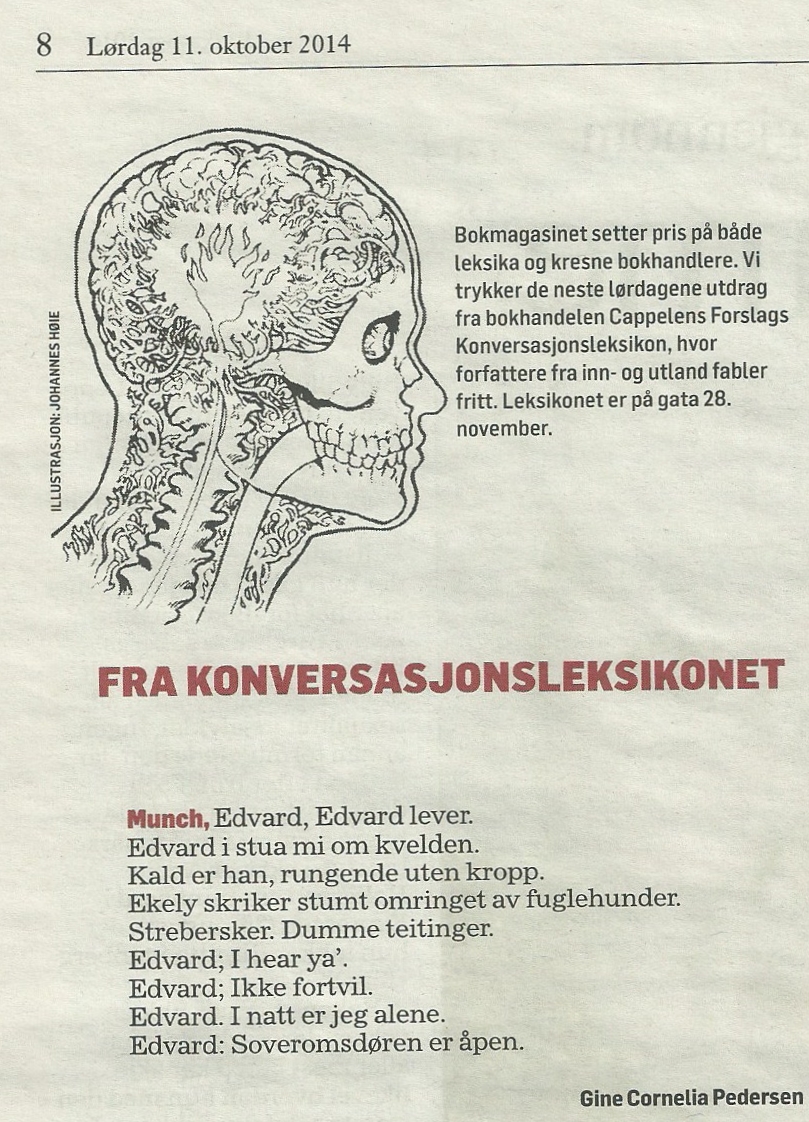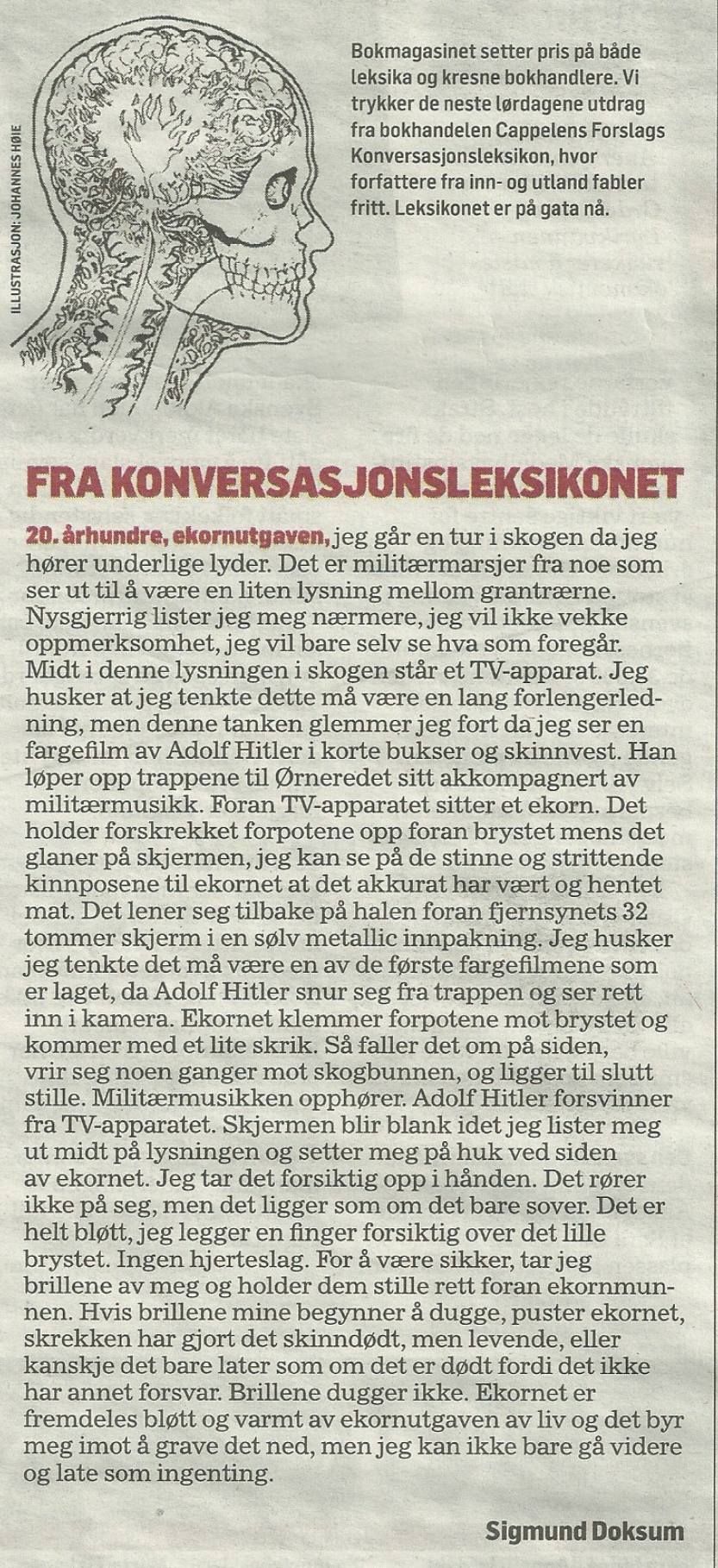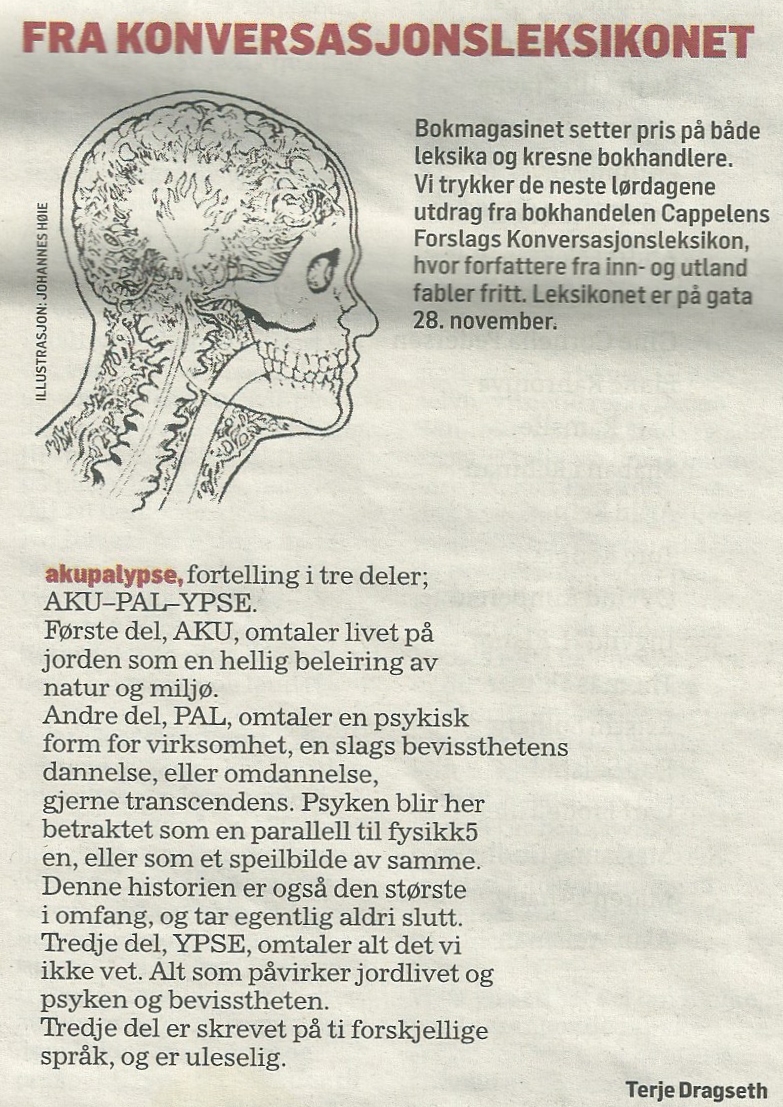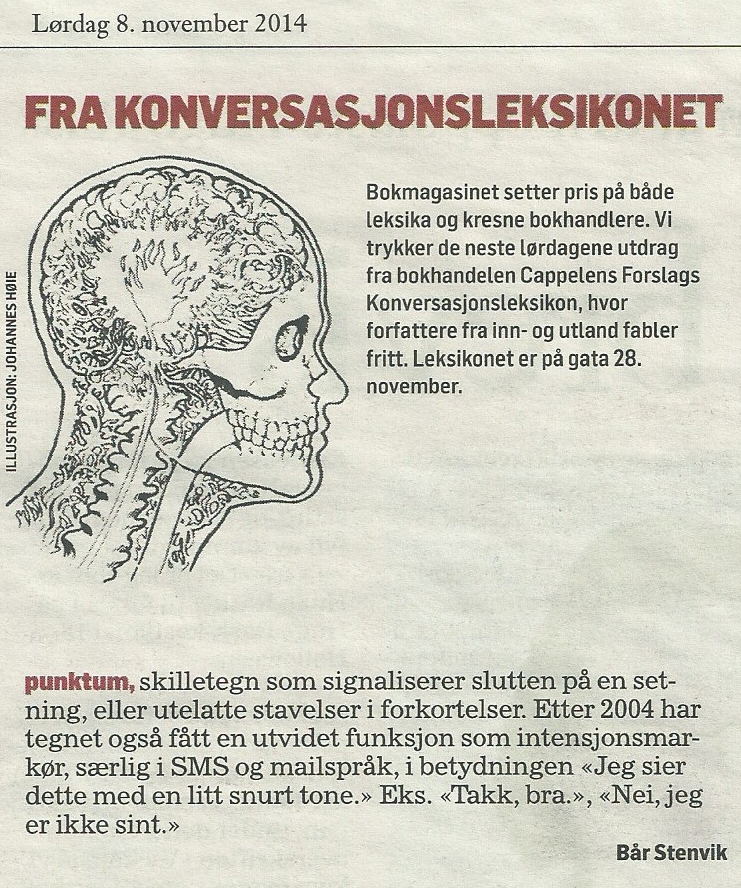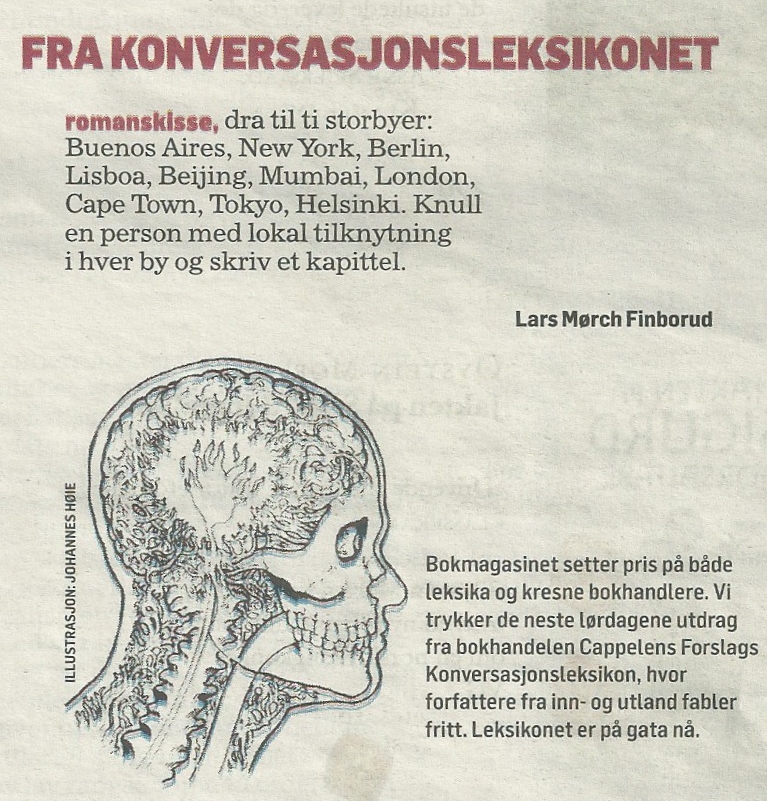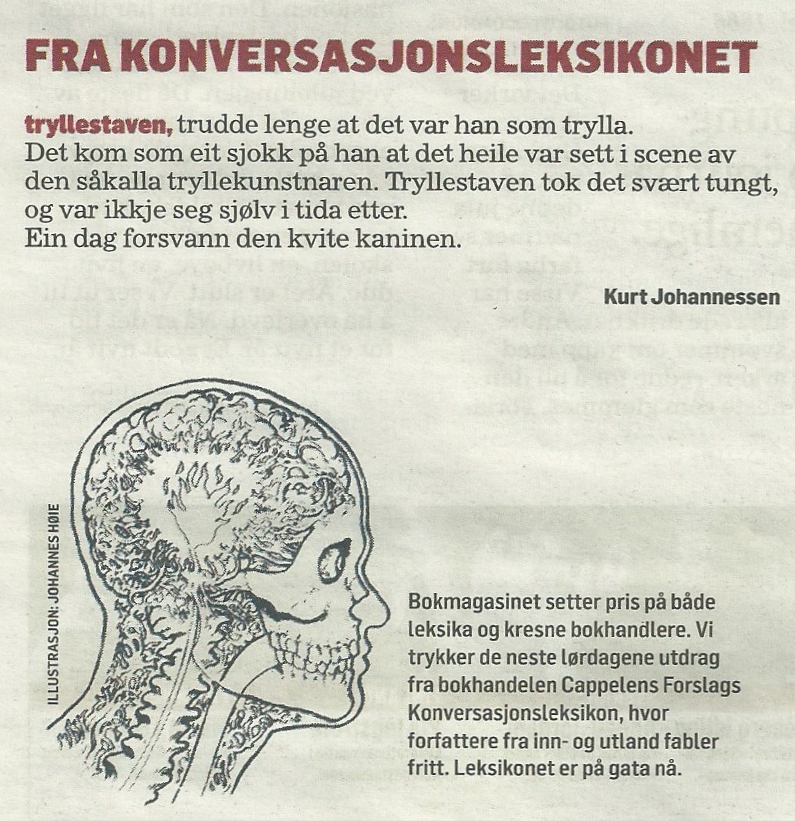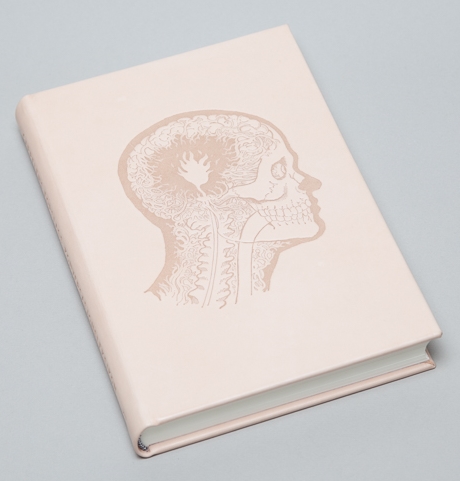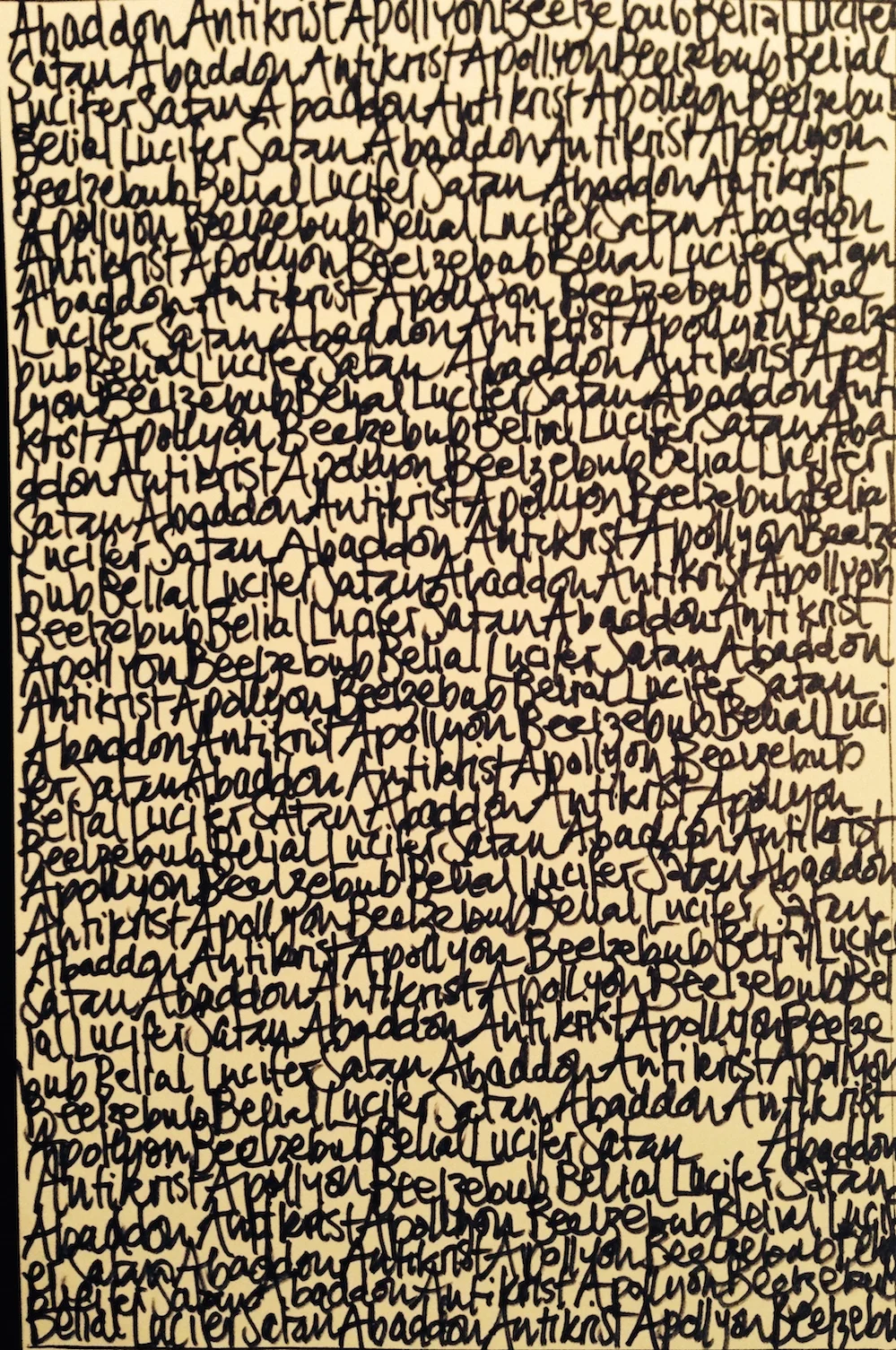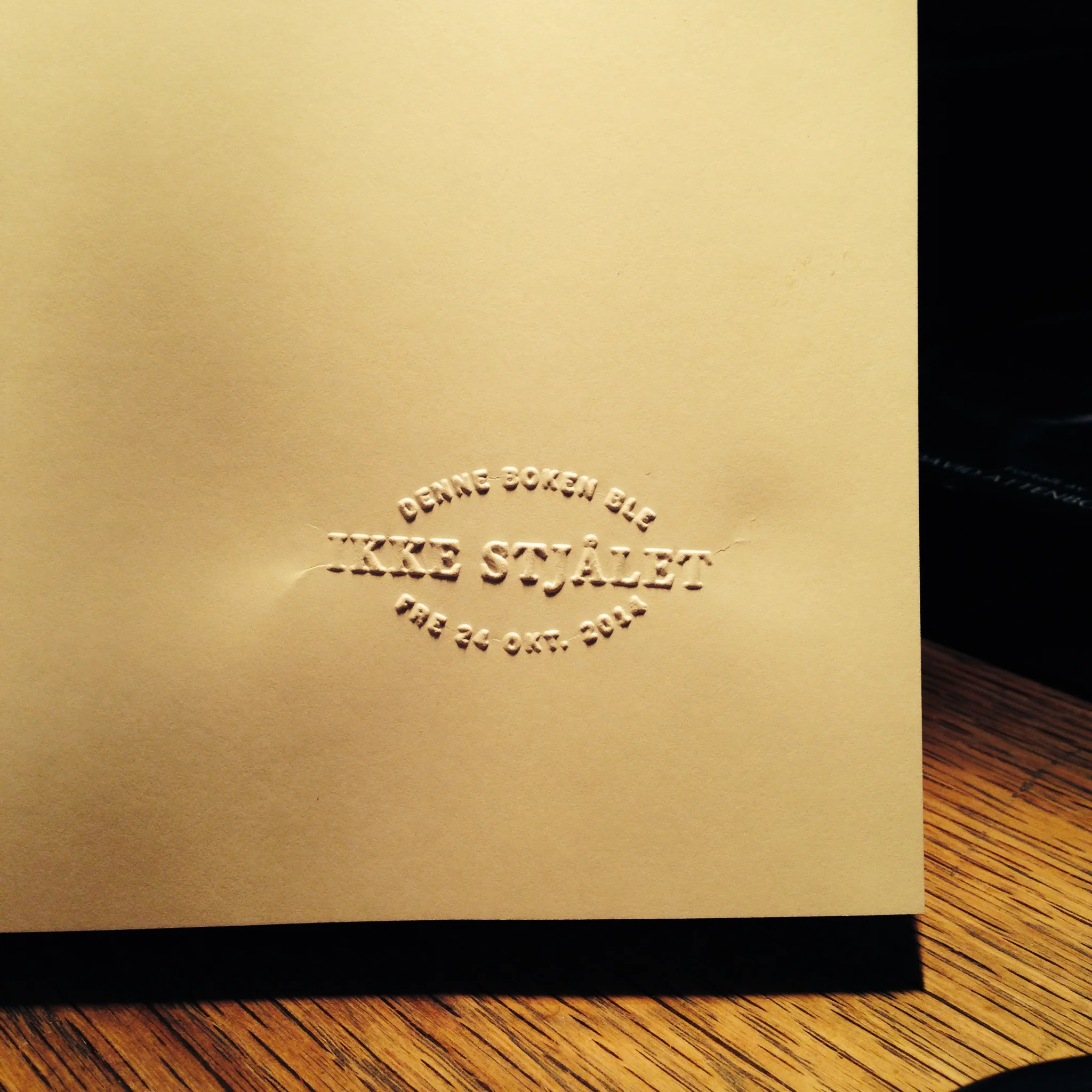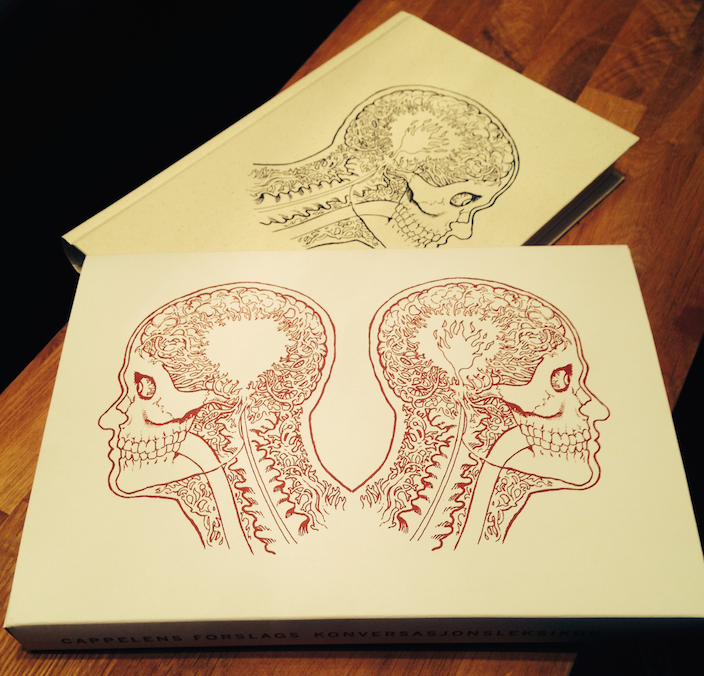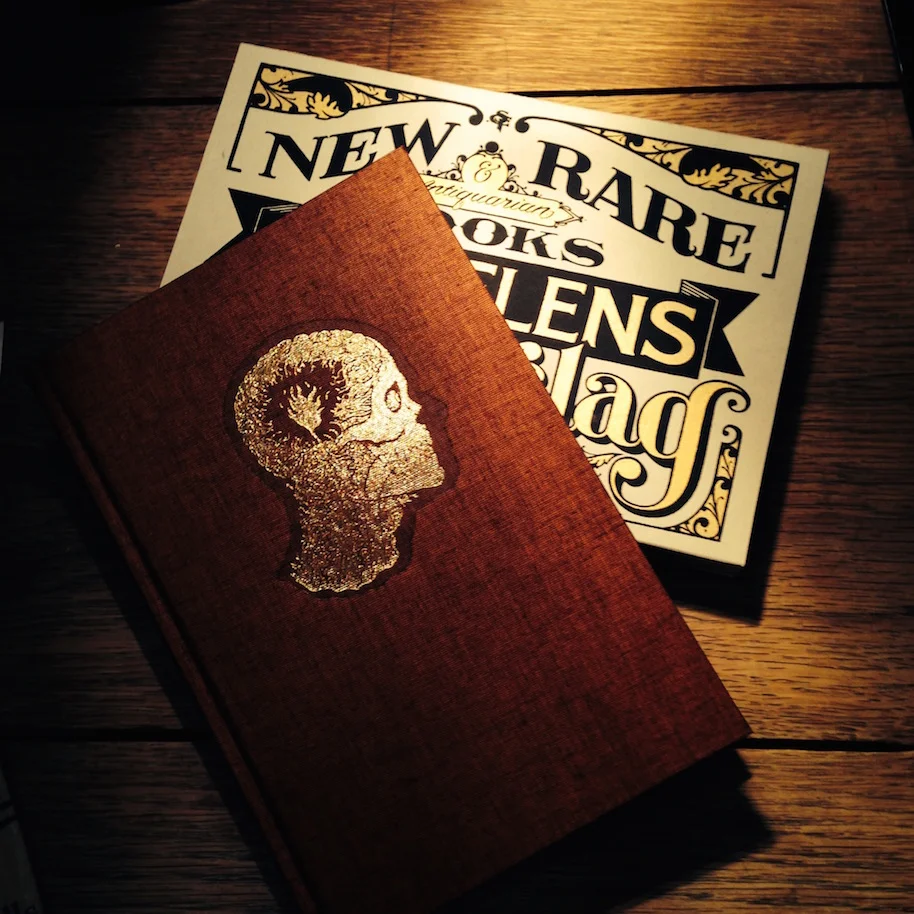ON CAPPELENS FORSLAGS CONVERSATIONAL LEXICON
with a guide to editions & their variants
Cappelens Forslags Conversational Lexicon (Cappelens Forslags konversasjonsleksikon) is an anthology in the form of a subjective encyclopedia, written by 87 mostly Scandinavian authors and artists and first published in Norway in 2014.
This is its story.
November 2014 saw the arrival of a weird and exciting new animal in the fauna of books and literature: Cappelen´s Forslags Conversational Lexicon. An unusual book, it felt novel and familiar at the same time. There was no title on the calfskin bound front cover, only a medical illustration showing a dissection of a human head. In the middle of the brain burned a lone flame. The illustration was embossed in the book´s leather binding using a letterpress more than a century old. If the book itself was ancient or brand new was impossible to tell by the cover; it seemed kind of ageless. Felt great to the touch though, and smelled incredible.
Calfskin bound hardcover variants, CFCL first edition
Its content and its origin, however, were entirely contemporary.
At the turn of the millennium the paper encyclopedia was becoming a dinosaur. From Merriam-Webster to the Petit Larousse, they headed for extinction as the internet replaced them as the largest repositories of knowledge and insight civilisation had to offer. Online dictionaries were a click away in every industrialized country, and soon enough, in every home, then pocket. The venerable paper versions couldn´t compete, and exist now only as snapshots of their time. In some of them, Zimbabwe will forever be Rhodesia, and no paper dictionary will explain the etymology of the selfie. So, on to the junkyard of history, to nestle among cathode ray tube televisions, bakelite telephones and asbestos dentures.
In Norway the last paper encyclopedia was published in 2003. Then, only crickets.
Until 2013, when independent bookstore co-owner Pil Cappelen Smith was feeling the pressure.
The shop he´d opened in in Oslo in 2011 with childhood buddy Andreas Cappelen (no relation), Cappelens Forslag, was a thing of beauty: a space for exploration and exchange of ideas, of reflection and (perhaps oddly) punk rock, dedicated to quality over quantity and love of literature over love of profit. It was great. Little wonder then that it had never once generated enough income to pay salaries, usually adding up just short of the monthly rent despite a small but beautiful customer base. Two years in and it was getting ridiculous. Only closing for good made any kind of sense, even to a seasoned magical thinker like Smith. It felt like being trapped under a chain store pallet of bestsellers. These were also the times of the Great E-book Panic, when a nervous publishing industry was trying to pitch those things as improvements on the paper book. That wasn´t gonna fly with Smith, to whom the e-book compared to the paper book the way an inflatable sex doll compares to the love of your life, and no goddamn compromise. The commercial foundering of the tiny book store left no patience for an attack on the paper book format itself. Something had to give.
Cappelens Forslag bookstore. The name is an untranslatable pun; remove the two S's from the name and it's identical with the name of one of Norway's biggest publishers. With the S's the name translates to "Cappelen's Suggestion".
Whether rescue plan or pipe dream, when the idea formed it went something like this:
Could a defunct book type like the paper encyclopedia be repurposed for something new?
If so, could it be made so extraordinarily tactile and pleasant that it could prove by example the necessity of paper books?
Could Smith slash costs by assuming the unpaid duties of publisher, editor, AD, promoter, contributor and secretary?
Would authors, artists and readers support such a quixotic project?
Sure!
Next: how to make a paper encyclopedia relevant when everyone and their grandmother has Wikipedia on their smartphone. Maybe by reversing the rules. The traditional encyclopedias were often used to finalize a discussion with objective fact; the last word on most subjects. This would be the opposite: dictionary articles as conversation starters. Freed from the demand for factual accuracy, these texts would forego consensus in favour of subjective examination; lying to tell the truth; lighting words, people, places and concepts from new angles just to see if they couldn´t mean something more or other than what they´d usually signified; to be messy, contradictory, wildly unpredictable. You know; interesting. They would tweak history and science to suit their purpose, play with languages, base definitions on emotions rather than facts, hoodwink, make absurd claims and preposterous statements, outright fabricate; all within a formal framework that in itself asserts the veracity of its content.
This book would be at war with itself: a dictionary you could disagree with. It was gonna be great.
Smith clearly couldn´t do this alone. He needed talented writers and money, and a lot of both. A reality check at this point was a waste of focus. This called for the kind of mindless optimism that had made opening an independent bookstore in 2011 sound like such a surefire proposal in the first place.
The to-do list, then:
- Find great writers & artists willing to contribute art and donate time
-Start worrying about production costs and how to cover them (soon)
Writer Paul Auster gave a talk in Oslo that spring. He was the first writer to have a letter delivered to him, asking if he and his wife Siri Hustvedt might like to contribute to the Conversational Lexicon. Auster left Norway, and a few weeks passed. Then, an email:
Dear Mr. Smith,
Thank you so much for asking Siri and me to participate in your project. In an ideal world we would love to do it but we are both swamped by so many obligations at the moment that I'm afraid it won't be possible. Please forgive us and all good luck with your subjective encyclopedia.
Best wishes, Paul Auster
A rejection letter from Paul Auster is still a letter from Paul Auster. This thing could obviously, absolutely, totally, 100% work. Maybe scale it down a tad, and approach people a little closer to home...
A year later the tally was 516 articles amounting to the fresh red excited heart of the thing. It boiled with energy, its beat irregular but strong. 215 pages written and illustrated by 87 contributors in five languages (the book is multilingual: each contribution is printed in the language it was written, i.e. Norwegian, New Norwegian, Danish, Swedish and English). While most contributors were established novelists, poets and musicians, some were outliers: One, a veteran policeman and former president of the Center for Crime Prevention in Toronto; another a film actor with Down´s Syndrome; yet another a death metal musician so popular in South America that his bands' lyrics merited the addition of Nordic studies at the university of Buenos Aires. The book´s lone American writer's credits include screenplays for the movies Rio, Rio 2 and Ice Age 3, while another contributor has only ever published on Facebook. One anonymous writer details a 200 year old manual for making a pact with the devil, in an easy, cut-out-and-use form. It was a mess of diverging styles and a pandemonium of voices. Shaping up nicely, thank you.
Still no money, though.
Some examples of the book´s look and content:
Magical thinking had inexplicably worked this far. When applied to financing it yielded the idea of going public and simply asking strangers to pay for the book in advance, to the tune of 250000 Norwegian crowns. That didn´t seem at all insane inside the bubble that was the book store, even though the cheapest version of the book would cost 600Nkr (€74 / $101). Indeed, the three monkfish-bound copies were priced at €1000 / $1372 each, which is just loopy. (Sold out, sorry.)
A crowdfunding campaign was begun in May 2014 with the goal of raising the very specific and pretty scary number of €31199 / $43149 to pay for printing, freight, promotion, materials and hand binding of 1000 copies of the Conversational Lexicon. As the 60-day campaign gained traction and word spread of this weird thing, it started to look like the crowd would in fact fund production of the book. As the campaign ended the project had been over-financed to the tune of 161%, totalling pledges for a staggering €50524 Euro / $69877 from 450 private funders. The readers had joined the writers in helping get this mutant creature airborne.
That's a go.
The book binder was commissioned to produce the first edition of 1100 numbered volumes in time for the release date of November 28, 2014. On its release, readers and book lovers were ecstatic, and full page reviews in Norway and Denmark very favorable. The series was sold out 8 days later, and the Conversational Lexicon was reprinted four times in the following year.
Cappelens Forslag's Conversational Lexicon, Volume IIwas published on November 26. 2016. Read about it here
Hand bound calfskin variants, CFCL first edition
A short film on the binding of CFCL:
Music: The Books - Smells Like Content
in 2015, the Norwegian Culture Council ordered a thousand copies for distribution among the nation´s libraries, and the book was nominated for a Golden Book prize by the Norwegian Publishers´ Association and the Booksellers´ Union.
A fourth reprint is planned for spring 2016. The Conversational Lexicon will never appear as an e-book.
The bookstore´s door remains open.
“The Bible, Cappelens Forslags konversasjonsleksikon and the Qur´an: These should be on your bookshelf. ”
“And dance with their pens, dipped in ink and blood, is what the 70 co-authors of Cappelens Forslags konversasjonsleksikon do. This is the book that only weeks upon its release has opened Scandinavia to a new conversation. Mission accomplished. Successfully.”
“It is an unequalled publication.”
These are some of the wise, funny and pulchritudinous creators of CFCL
ISBN: 978-82-999643-1-9 Editor, publisher: Pil Cappelen Smith / Book binder: Thomas Støyva
Cover illustration: Johannes Høie / Type & layout: Mikkel Cappelen Smith / Print: Tallinn Book Printers
Some short definitions from CFCL in translation:
asphalt, 1. The surface in front of you, steaming; as the steamroller passes you realise you're late, school must have started already. You throw your leg over the crossbar and grip the handlebars harder, stand still for a moment inhaling the smell of tarmac, then kick off and pedal around the corner, lean forward on top of the slope, and you see, in an instant, that the seventh graders are gone, there's nobody in the school crossing, you see the the cars on the road trying to brake for you, soundlessly, like a silent movie, the wind fills your ears and you fly through the crossing; the world is open, it's spring.
2. Reflector for the orange light observable near streetlights in the rain, for example outside the house with the doorbell you're no longer allowed to ring yet can´t stay away from. You stand under the maple tree, listening to the children´s voices through the open window as you consider the orange, gnarled, shiny entrails of the sidewalk.
Karine Nyborg
brothers, those who mock your father.
Bård Torgersen
CD-s (that jump out of their shelves and destroy their covers), a phenomenon known to most.
Some CD-s simply will not sit still on a shelf or lie flat on, say, a dresser. They absolutely must leap into open space and damage themselves. An impressive urge for self-destruction. No solid explanation has ever been found for this. The main offender in my CD collection is The Very Best of the Chi-Lites. I find nothing in their music to imply such behaviour.
Ragnar Hovland
death penalty, an excellent method to keep population numbers in check following the prohibition of mandatory sterilisation. One of the most effective population culling measures in existence, in addition to organised warfare, withholding cures for diseases like polio or diphteria and allowing the unlimited spreading of HIV/AIDS. The death penalty is tidy, practical and easy to implement. Regimes worldwide report positive experiences with this method of punishment, citing reduced bureaucracy and increased political elbow room. Nations that do not practice the death penalty are recommended by the World Health Organization to introduce it before 2025.
Hilde Østby
Devil, the, non-existent entity who keeps proving his existence by frightening people with their evil deeds.
Kurt Aust
Equity, Emperor Lucifer, master of all rebellious spirits, I beseech thee: be favorable to me in the calling which I make upon the great minister DEMON PRIEST, having desire to make a pact with him. I pray thee also, protect me in my undertaking.
O Count Ashtoreth! Be propitious to me, and cause that this night the Great Demon appear unto me in human form and without any evil smell, and that He grant me, by means of the pact I shall deliver to Him, all the riches of which I have need.
O Great Demon, I beseech thee leave thy dwelling, in whatever part of the world it may be, to come and speak with me; if not, I will thereto compel thee by the power of the mighty words of the Key of Solomon, whereof he made use to force the rebellious spirits to accept his pact.
Appear then, instantly, or I will continually torment thee by the mighty words of the Key:
Aglon Tetagram Vaycheon Stimulamathon Erohares Retragsammathon Clyoran Icion Esition Existien Eryona Onera Erasyn Moyn Meffias Soter Emmanuel Sabaoth Adomai, Misericors Deus Praedecessoribus Croftum, I summon thee, Amen.
The Demon will now appear, and say:
I assent to your demand, on condition thou give me thyself at the end of seven years, so that I do with thee, body and soul, what shall please me.
The negotiator shall now throw at the Demon the pact, which must be written in his own hand on a small piece of virginal parchment, and which must consist of the following words, signed in his own blood:
I swear unto the Great Demon to repay Him in seven years from now for all He shall bestow upon me.
In witness whereof I have signed:
____________________________________________
NN
god, an invisible entity, also known as Allah or Yahweh, claimed by some to be responsible for the Big Bang (see: Big Bang) and the whole cosmic shebang. The entity will be mightily annoyed with you if you eat pork, drink booze, are gay, don´t confess your sins, don´t make a pilgrimage to Mecca, masturbate, covet another man´s wife, consort with lepers and so on. The entity has nothing much on the calendar except monitoring these things closely. It is so far unknown why it would derive any pleasure from such a pursuit.
Gert Nygårdshaug
jealousination, to jealousinate. A jealous man will see only what he does not want to see.
Joakim Kjørsvik
magic wand, the, thought for the longest time that it was he who was performing the magic. It came as a shock to him that the whole thing had been staged by the so-called magician. The magic wand was hit hard by this. He wasn´t himself in the time that followed. One day the white rabbit disappeared.
Kurt Johannessen
mummy, it´s hard to hear the lines through the bandages. It´s impossible to see the facial expressions through the bandages. Mummies stick to grand gestures: rises from the grave. Lies down in the grave. One raised arm means one thousand years. Two raised arms means two thousand years.
Or: No-one can replace us.
Sigmund Doksum
psychopath, someone who always cries in the right places at funerals.
Kjersti A. Skomsvold
ringhole, the place on the body where the wedding ring is kept after the marriage has broken down.
Bård Torgersen
rock'n'roll,
Photo: Travis Shinn
sarcasm, great rhetorical instrument; makes its user seem real smart.
Ola Jostein Jørgensen
starting point, the first thing we can make a note of is that a contraction is shaped like a white circle, about the size of an orange. The innermost stripe in the white ring glows a phosphorous white. The ring then forces itself towards its own center, sucks itself in there, making the white more and more phosphorous, while the shape itself, i.e. the ring, grows smaller and smaller until the ring and the white become one and is a ring no more, only a white, shining point. This point is what is known as the starting point.
Gunnhild Øyehaug
Further examples (in Norwegian):
From newspaper Klassekampen´s weekly Book Magazine, fall 2014 (in Norwegian):
On editions 1-4 and their variants
Cappelens Forslags Conversational Lexicon, first edition
The first edition of Cappelens Forslags Conversational Lexicon was published in a number of variants, all hand bound, of which the main categories break down like this:
Numbers 2 - 1010: Standard calf-, baby buffalo or goatskin binding. Hard ( skin glued onto a layer of board ) or soft (without same), smooth or suede cover, coloured grey, tan, beige, brown, with individual nuances owing to skin thickness, the animal´s life experience, the heat and/or pressure applied to the cliché at the time of embossing etc.
Numbers 1011 - 1013: Monkfish hide binding. Numbered separately in a 1-3 series
One of three monkfish-bound hardcovers, CFCL first edition
Numbers 1014 - 1100: Author´s copies. Different colophon text from the market copies. Each copy is embossed on the front cover with the contributor's name and the word “Med” (“With”) + author´s name, and is as such the only one of its kind.
Author´s copy
The one volume that deviates the most from all others (and consequently is the rarest copy in existence) is lexicon no. 666, which is unique in a number of ways. It is the only copy bearing the cover illustration embossed upside down. A cliché for the text on the spine was manufactured to be used only once: on it the letters Cappelens Forslags konversasjonsleksikon have been changed to Cappelens Forslags konversatansleksikon. Furthermore, a page in this copy contains an almost finished Devil´s palimpsest, and the ISBN number has been changed into Belfegor´s Prime, the numerological representation of the number of the beast. It has red headbands and is bound in black leather.
Possibly also contains the editor´s signature in blood on page 33, on which a standard contract with the devil is printed under the article heading “equity”.
Another one of a kind first edition copy is #1 in the series. It was the book binder´s very first finished copy, and was exhibited in the bookstore´s window when the shop was broken into and burgled in October 2014. As no footage of the burglary existed and the police were less than enthusiastic about pursuing the thief, books #2 - #1013 (every copy but the 87 author´s copies which are unique in themselves) were embossed on the title page with the text: “This book was not stolen on Friday Oct. 24, 2014”. The stolen copy is the only one without this mark, and so is very easy to spot. Hopefully it will one day be returned to the shop, no questions asked (or at least sold at a high price befitting its provenance). We´ll see.
Cappelens Forslags Conversational Lexicon, library edition/ Third edition
The library/third edition was printed in a run of 1200 copies when the Norwegian Culture Council ordered 1000 books in January 2015 for distribution among Norway´s libraries.
Since libraries routinely laminate their books, the leather-bound edition was out of the question. The library edition was created to meet this challenge and optimised for lamination. This edition is a factory-produced hardcover bound in the paper Gmund Bier Papier: Lager. This paper contains used grain from German beer production which is added to the paper pulp before it is rolled into sheets. The grain is visible as small brown spots on the book cover. The surplus 200 copies were presented in a silk screened cardboard box. 87 of these were earmarked author´s copies; the rest were sold in the bookstore.
Cappelens Forslags Conversational Lexicon, 1 year anniversary edition / Fourth edition
The fourth edition was released on the one year anniversary of the first. It was once again hand bound in calf or baby buffalo, in both soft and hard cover variants, but this time in a series of 500 numbered copies. It was different to the first edition in that this series had the book's title printed on the front cover. This was the last time the book would made by hand.
Calfskin bound hardcover variants, CFCL 4th edition
Cappelens Forslags Conversational Lexicon, standard ed. / Second edition
The second edition was printed in a run of 2000 factory made copies concurrent with the release of the first leather bound edition. The front cover illustration is in gold foil and letterpressed onto the book by hand. It was released two weeks after the first as it became clear that the first edition would sell out in a matter of days. A mad scramble to have more copies available to the public followed. The bookstore's two employees and a friend flew to Tallinn Book Printers, their printer in Tallinn, Estonia, and filled nine suitcases to the brim with books straight off the press.
(This is where it got a little crazy. On their return trip to the airport they had to overcome challenges of Verne-ian proportions: fire, frozen rivers, a romance with the daughter of an exiled political prisoner, and a short stint as captives of Feofar Khan´s irascible Tartan hordes, who had arrived in Estonia following a failed siege of Irkutsk and itching for a quick victory.
After searching the nine suitcases, and confusing the front cover illustration of the Conversational Lexicon with the national flag of Corsica, the Tartan Khan accused them of espionage. This came close to costing our friends their eyesight. Which they needed to find the correct counter for check-in at the airport, if only they´d ever get there; boarding would start soon, and before that they´d have to weigh the baggage, pay overweight at the other side of the terminal, passport control etc., it's just hell. Anyway: The Khan decided on their punishment by opening his holy Qur´an to a random page and pointing with his eyes closed. Thus he divined that the spies should be blinded. The punishment was to be performed in the traditional Tartan manner of dragging a red hot sword across the victim´s eyes. The Khan had appointed a kharagdana (“ember-er”) for this purpose, whose task it was to always place a sword in the campfire which must be hot enough to evaporate an eyeball, but well under the melting point of 1.130 °C. A limp weapon would have embarrassed everyone. In such an event the kharagdana would be struck to the ground, hid from the horses under a blanket and galloped over by the entire horde. Bet he knew exactly what the minimum temperature was. And so the book dealers were forced to their knees and given their punishment, and if you´ve ever smelled that smell you won´t forget in a hurry.
They were then set free, and stumbled out of the Mongol camp. Everyone who knows them thought they were blind for months upon their return. However, in the end it was revealed that they could still see. The explanation was the same for all three: during their ordeal, their thoughts turned to their mothers; the resulting tears were trapped between the hot steel and their corneas - thus their eyesight was spared.
Under such circumstances it´s a small miracle that they caught their flight to Oslo.
They made it to the airport in time, only to face an even bigger horror in the form of overweight baggage rates.
What happened to the Khan is lost to history. Only this is known: he was crap at recognising flags. Maybe it´s a Mongol thing. The Corsicans would never have made that mistake.)
I have to apologise at his point. Nothing in parenthesis actually happened to us. Well, none of the exciting bits. A lot of it happened to Michael Strogoff though, in Jules Verne´s The Courier of the Czar. I thought of that story for some reason and got a bit carried away.
If you got this far you´re a forgiving reader. Thank you.
Want to learn about the second volume? Read more here

